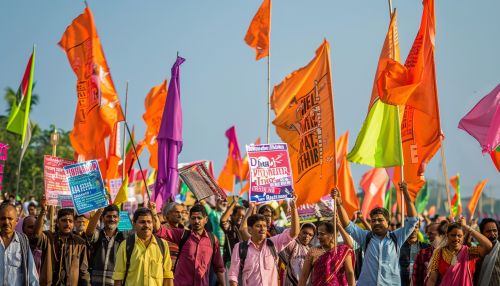Political parties in the United States
Overview
Political parties in the United States are integral to the nation's political system, serving as the primary means through which individuals and groups organize to compete for political power. The U.S. has a two-party system, dominated by the Democratic Party and the Republican Party. However, numerous third parties and independent candidates also play roles in the political landscape, influencing policy debates and election outcomes.
Historical Development
Early Political Parties
The origins of political parties in the United States can be traced back to the early years of the Republic. The first political parties were the Federalist Party and the Democratic-Republican Party, which emerged in the 1790s. The Federalists, led by Alexander Hamilton, advocated for a strong central government and a loose interpretation of the U.S. Constitution. In contrast, the Democratic-Republicans, led by Thomas Jefferson and James Madison, supported states' rights and a strict interpretation of the Constitution.
The Era of Good Feelings
The decline of the Federalist Party after the War of 1812 led to a period known as the Era of Good Feelings, characterized by a lack of partisan conflict and the dominance of the Democratic-Republican Party. This era was short-lived, as internal divisions within the Democratic-Republicans gave rise to new political factions.
The Second Party System
By the 1820s, the Democratic-Republican Party had split into two main factions: the Democratic Party, led by Andrew Jackson, and the National Republican Party, which later evolved into the Whig Party. The Democratic Party championed populist policies and opposed centralized banking, while the Whigs supported modernization and economic protectionism.
The Third Party System
The 1850s saw the collapse of the Whig Party and the rise of the Republican Party, founded on anti-slavery principles. The American Civil War and Reconstruction Era solidified the Republican Party's dominance in the North, while the Democratic Party maintained strong support in the South.
The Fourth Party System
The late 19th and early 20th centuries, known as the Progressive Era, witnessed significant political and social reforms. The Republican Party, led by figures such as Theodore Roosevelt, embraced progressive policies, while the Democratic Party, under leaders like Woodrow Wilson, also adopted reformist agendas.
The Fifth Party System
The Great Depression and the New Deal policies of Franklin D. Roosevelt marked the beginning of the Fifth Party System. The Democratic Party became the party of social welfare and labor rights, while the Republican Party positioned itself as the defender of free-market capitalism and limited government.
The Sixth Party System
The Sixth Party System, which began in the late 20th century, is characterized by increased political polarization and the realignment of party coalitions. The Democratic Party has increasingly focused on social justice, environmentalism, and progressive taxation, while the Republican Party has emphasized conservative social values, deregulation, and tax cuts.
Structure and Organization
National Committees
Both major parties have national committees that oversee party operations and strategy. The Democratic National Committee (DNC) and the Republican National Committee (RNC) are responsible for organizing the national conventions, coordinating campaign activities, and fundraising.
State and Local Organizations
Political parties in the United States are organized at the state and local levels, with state parties operating independently but in coordination with the national committees. Local party organizations play a crucial role in grassroots mobilization, candidate recruitment, and voter outreach.
Party Leadership
Party leadership is typically composed of elected officials, party chairpersons, and influential activists. Leadership positions within the party are often determined through internal elections and appointments.
Electoral Influence
Presidential Elections
In presidential elections, political parties play a central role in nominating candidates through primary elections and caucuses. The Electoral College system further emphasizes the importance of party organization and strategy in securing electoral votes.
Congressional Elections
Political parties also influence congressional elections, with party committees such as the Democratic Congressional Campaign Committee (DCCC) and the National Republican Congressional Committee (NRCC) providing support to candidates.
State and Local Elections
At the state and local levels, political parties are involved in gubernatorial, legislative, and municipal elections. State parties often collaborate with national committees to support candidates and promote party platforms.
Third Parties and Independents
While the two-party system dominates U.S. politics, third parties and independent candidates have historically impacted elections and policy debates. Notable third parties include the Libertarian Party, the Green Party, and the Constitution Party. Independent candidates, such as Ross Perot and Bernie Sanders, have also influenced political discourse.
Party Platforms and Ideologies
Democratic Party
The Democratic Party's platform emphasizes social justice, economic equality, and environmental sustainability. Key policy areas include healthcare reform, climate change mitigation, and civil rights protections.
Republican Party
The Republican Party's platform focuses on limited government, free-market principles, and conservative social values. Key policy areas include tax cuts, deregulation, and national security.
Third Party Platforms
Third party platforms vary widely, reflecting diverse political ideologies. The Libertarian Party advocates for minimal government intervention, the Green Party prioritizes environmental issues and social justice, and the Constitution Party emphasizes strict adherence to the Constitution.
Political Polarization and Partisanship
Political polarization has increased in recent decades, with significant ideological divides between the Democratic and Republican parties. This polarization has led to heightened partisanship and legislative gridlock, impacting the effectiveness of governance.
Conclusion
Political parties in the United States play a crucial role in shaping the nation's political landscape. From their historical development to their current influence on elections and policy, parties are central to the functioning of American democracy. Understanding the structure, organization, and ideologies of these parties provides insight into the complexities of U.S. politics.


